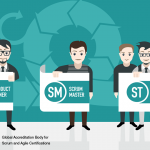Business justification is first assessed prior to a project being initiated and is continuously verified throughout the project lifecycle. The following steps capture how business justification is determined:
1. Assess and Present a Business Case
Business justification for a project is typically analyzed and confirmed by the Product Owner. It is documented and presented in the form of a project Business Case prior to Initiate phase and involves considering the various factors. Once documented, the Product Owner should create a Project Vision Statement and obtain approval of the Project Vision Statement from the key decision-makers in the organization. Generally, this consists of executives and/or some form of a project or program management board.
2. Continuous Value JustificationOnce the decision makers approve the Project Vision Statement, it is then baselined and forms the business justification. The business justification is validated throughout project execution, typically at predefined intervals or milestones, such as during portfolio, program, and Prioritized Product Backlog Review Meetings and when major issues and risks that threaten project viability are identified. This could happen in several Scrum processes. Throughout the project, the Product Owner should keep the business justification in the Project Vision Statement updated with relevant project information to enable the key decision makers to continue making informed decisions.
3. Confirm Benefits Realization
The Product Owner confirms the achievement of organizational benefits throughout the project, as well as upon completion of the User Stories in the Prioritized Product Backlog.
The following figure summarizes the steps to determine business justification.
Analysis of business justification helps decision makers in understanding the business need for a change or for a new product or service and the need for moving forward with a project. It also helps the Product Owner to create a Prioritized Product Backlog along with the business expectations of Senior Management & Stakeholder(s).









